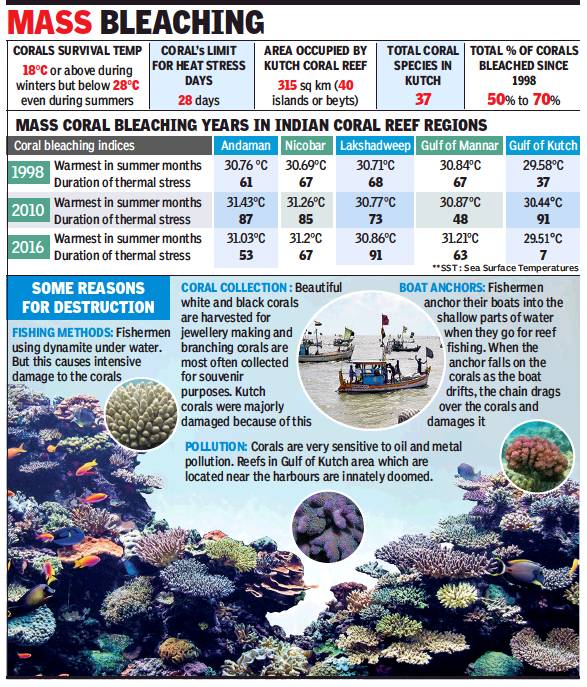Coral reefs: India
This is a collection of articles archived for the excellence of their content. |
Contents |
Reefs, species in India
An overview

From: June 19, 2018: The Times of India
See graphic:
Coral reefs, species in India
Climate threat
Mass bleaching/ 1998, 2010, 2016
Paul John, August 27, 2019: The Times of India

From: Paul John, August 27, 2019: The Times of India
Coral reefs — the marine wonders that leave us awestruck by their rockpools of colour — are under climate threat. A recent study, published in the reputed science journal Current Science, shows that they are slowly bleaching away on the Gujarat’s Gulf of Kutch shores.
A major reason is the frequent ‘ocean heat waves’ or thermal stress owing to climate change, coupled with anthropological issues.
Bleaching means the change in colour of the corals because of the decay in algae living in their tissues as symbiotic partners.
The algae is also the reason that gives the corals their distinct colour. As sea temperature rises above normal summer maxima the corals are forced to expel the algae and turn white. These bleached corals thereafter get prone to disease and ultimately die.
A study undertaken by Isro’s Space Applications Centre (SAC) research team and the department of geophysics, Kurukshetra University analysed sea surface temperatures (SST) from 1982 has reported increased number of heat stress days. The study includes three distinct years of ‘Mass Coral Bleaching’ (MCB) instances of 1998, 2010 and 2016 recorded during the El Nino Southern Oscillation (ENSO) that caused abrupt rise in sea temperature. The thermal stress of 2010 was the worst for corals of Gulf of Kutch coasts, when mass bleaching occurred.
The data reveals that extremely sensitive carbonate reef structures are commonly built up in tropical regions where sea water temperatures exceed 18 degree Celsius during winter and remains below 28 degree Celsius in summer.
However, in 1998, the Isro-SAC study found that the SST exceeded to 29.58 degree Celsius. Also, against the ideal span of 28 days, the number of heat stress days stood at 37. In 2010 SST went up to 30.44 degree Celsius, while the total heat stress days rose to 91 days. During the 2016 temperature went up to 29.91 degree Celsius while the number of heat stress days stood at 70.
Normally corals can re-establish themselves (or return to their pre-bleaching state) in a decade or two. “But the quick frequency and intensity of MCB overwhelms the coral reefs ability to recover from heat stress episodes,” the study says.
The study utilised data from US-based National Oceanic and Atmospheric Administration (NOAA) and corroborates findings of Suganthi Devadason Marine Research Institute, Tuticorin on the bleaching of corals of the Gulf of Kutch.
The study undertaken in 2016 found 13 of the total 37 coral species had bleached during the 70 days of prolonged heat stress.
The study conducted by Space Applications Centre scientists Mohit Arora, Nandini Chaudhry and Ashwin Gujrati and Ramesh Patel of the department of Geophysics, Kurukshetra University.
Marine archæology
Warship near Kalpeni
Ragu Raman, January 5, 2025: The Times of India

From: Ragu Raman, January 5, 2025: The Times of India
Chennai : A group of divers exploring marine life near Kalpeni island in the Lakshadweep archipelago stumbled on Saturday morning upon the wreck of what, it appeared, had been a warship.
Going by the nature of the wreck, researchers believe the ship, fitted with cannon, might have belonged to any of the three European powers — Portuguese, Dutch or British — and was sunk sometime during the fight for supremacy over the ancient maritime route connecting the Middle East and Sri Lanka in the 17th and 18th centuries.
“When we spotted the wreck on the western side of Kalpeni, we didn’t know it was a warship. When we found a cannon and an anchor, we realised it could be an important find,” said Satyajeet Mane, a marine explorer who led the group of divers from Brannadives. They said they would inform the local authorities.
Wreckage could be of European warship: Diver
We found it at a depth of just four or five metres at the mouth of a lagoon. The wreckage appears to be spread over the deeper parts of Arabian Sea, said Mane, adding, “Going by size of the ship, the can- non, and the metal, it could be a European warship. More exploration is needed.”
Idrees Babu, a scientist at department of science and technology and a mentor to the divers’ group, said such a shipwreck has not been recorded in the region earlier. “The ship might have been 50m-60m in length. East India Company started using iron ships on this trade route in the 17th or 18th century. We need underwater archaeological studies to learn more about it; till then we need to protect the site,” he said.
When the British used iron ships, the Portuguese con- tinued to use ships made of iron & wood. “The coral growth on the wreckage and corrosion make it difficult to immediately ascertain if the ship was made fully of iron or it had components of wood too. The coral growth indicates it has been submerged for a few centuries,” said Mane.